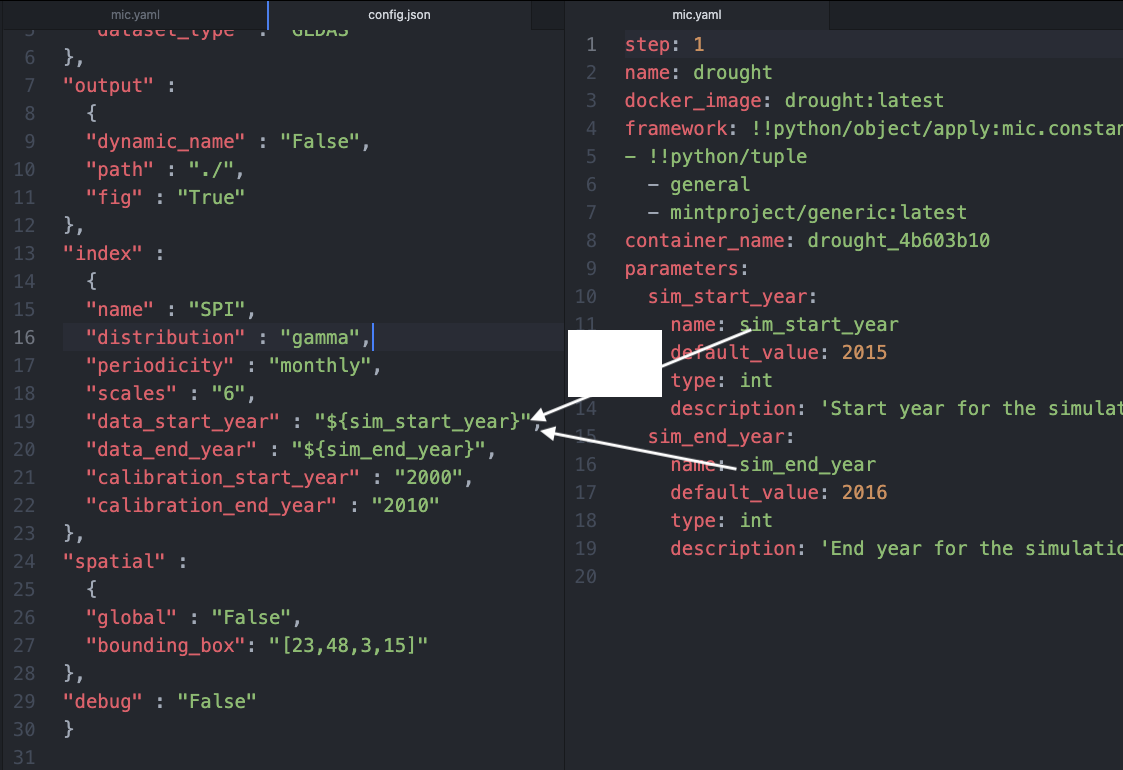4. Editing component configuration files
Warning
DO NOT CLOSE the terminal in-between each step.
After inspecting the mic.yml file in-between steps, CLOSE the file.
Preparing your configuration file¶
The MINT wrapper can replace the values of the parameters in their right configuration files, but it needs to know where they are. Therefore, we need to define placeholders in the configuration files stating which value will be replaced.
In the previous step, we defined two parameters that a user may change, which corresponds to the start and end of the simulation and named them sim_start_year and sim_end_year and we assigned them default values. Now we need to indicate to MIC where these parameters are located in the configuration file.
Let's open config.json:
{
"data" :
{
"dataset_name" : "GLDAS2.1_TP_2000_2018.nc",
"dataset_type" : "GLDAS"
},
"output" :
{
"dynamic_name" : "False",
"path" : "./",
"fig" : "True"
},
"index" :
{
"name" : "SPI",
"distribution" : "gamma",
"periodicity" : "monthly",
"scales" : "6",
"data_start_year" : "2015",
"data_end_year" : "2016",
"calibration_start_year" : "2000",
"calibration_end_year" : "2010"
},
"spatial" :
{
"global" : "False",
"bounding_box": "[23,48,3,15]"
},
"debug" : "False"
}
and replace:
- the value
2015with ${sim_start_year} - the value
2016with ${sim_end_year}
{
"data" :
{
"dataset_name" : "GLDAS2.1_TP_2000_2018.nc",
"dataset_type" : "GLDAS"
},
"output" :
{
"dynamic_name" : "False",
"path" : "./",
"fig" : "True"
},
"index" :
{
"name" : "SPI",
"distribution" : "gamma",
"periodicity" : "monthly",
"scales" : "6",
"data_start_year" : "${sim_start_year}",
"data_end_year" : "${sim_end_year}",
"calibration_start_year" : "2000",
"calibration_end_year" : "2010"
},
"spatial" :
{
"global" : "False",
"bounding_box": "[23,48,3,15]"
},
"debug" : "False"
}
Make sure that the names of the parameters match with the names we described in step2! Otherwise MIC will not be able to replace the values accordingly:

How to perform this step?¶
Once the mapping has been completed, we just need to add the file as a configuration file of the model component:
mic pkg configs [configuration_files]...
In the example, we must run
$ (climate) root@d8826beb2c59:/tmp/mint# mic pkg configs config.json
Found mic.yaml in /tmp/mint/mic/mic.yaml
Added: /tmp/mint/config.json as a configuration file
Info
The -a option will automatically recognize any parameter under ${parameter_name} in the configuration files and add it to the mic.yaml file automatically. This way you can change them directly without having to perform the mapping yourself in step 3.
Expected results¶
The mic.yaml will have been updated with a new field named configs:
parameters:
sim_start_year:
name: sim_start_year
default_value: 2015
type: int
description: Start year for the simulation
sim_end_year:
name: sim_end_year
default_value: 2016
type: int
description: End year for the simulation
configs:
config_json:
path: config.json
format: json
Help command¶
Usage: mic pkg configs [OPTIONS] CONFIGURATION_FILES...
Note: If your model does not use configuration files, you can skip this
step
Specify which parameters of your model component you want to expose from
any configuration file.
- You must pass the MIC_FILE (mic.yaml) as an argument using the (-f)
option or run the command from the same directory as mic.yaml
- Pass your model configuration files as arguments
mic pkg configs -f <mic_file> [configuration_files]...
If you have manually changed some parameters, the -a option will attempt
to recognize the configuration files automatically
Example:
mic pkg configs -f mic.yaml data/example_dir/file1.txt
data/file2.txt
Options:
-f, --mic_file FILE
-a, --auto_param Enable automatic detection of parameters
--help Show this message and exit.